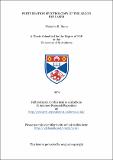Files in this item
Perturbation spectroscopy of the argon ion laser
Item metadata
| dc.contributor.advisor | Maitland, Arthur | |
| dc.contributor.author | Dunn, Malcolm H. | |
| dc.coverage.spatial | 175 p. | en_US |
| dc.date.accessioned | 2018-06-18T09:21:05Z | |
| dc.date.available | 2018-06-18T09:21:05Z | |
| dc.date.issued | 1974-06 | |
| dc.identifier.uri | https://hdl.handle.net/10023/14161 | |
| dc.description.abstract | The technique of perturbation spectroscopy has been applied to study the argon ion laser discharge. In this technique the laser radiation field present within the active medium is switched on and off, and this modulates the population of the upper laser level. By studying the magnitude of these modulations as discharge conditions within the active medium are changed, the copulation inversions on the 4p2D5/2 - 4s2P3/2 and 4p4D5/2 - 4s2P3/2 laser transitions have been explored. By studying, in the presence of an applied magnetic field, the polarization induced in the spontaneous emission sidelight through these modulations, the lifetime of the 4p2D5/2 upper laser level has been estimated. By studying the population changes induced on other 4p and 4d levels as a consequence of the population change on the upper laser level, the relative importance of various proposed excitation mechanisms for the 4p upper laser levels have been assessed. The population inversions (1 - g1N2/g2N1, where N1 is the population of the upper laser level and N2. the population of the lower laser level) on the 4p2D5/2 - 4s2P3/2 and 4p4D5/2 - 4s2P3/2 transitions of Ar II are destroyed by increasing the argon pressure above 0.2 - 0.3 Torr, and for higher pressures the medium exhibits absorption. Both population inversions increase slowly with discharge current. By using a flow graph technique to analyse the population inversions, this latter is shown to imply that the electron temperature in the discharge increases with current. The polarization experiments have been analysed by both a simple rate equation treatment, and by a more complete approach based on Lamb theory. This latter treatment demonstrates that the dependence of polarization ratio on magnetic field can be used to determine the lifetime of the upper laser level. Polarization ratios on the 4p2D5/2 - 4s2P3/2 and 4p4D5/2 - 4s2P3/2 transitions have been measured as a function of discharge parameters and applied axial magnetic field. From the variation of polarization ratio with magnetic field, the lifetime of the 4p2D5/2 level of Ar II under discharge conditions has been estimated. The perturbations in the populations of other 4p and 4d levels of Ar II resulting from the modulation of the upper laser level have been measured as a function of discharge parameters. Their magnitudes and dependence on discharge current provide direct evidence that an important excitation pathway for the 4p upper laser levels of Ar II is step wise excitation through the quartet 4s levels of Ar II. | en_US |
| dc.language.iso | en | en_US |
| dc.publisher | University of St Andrews | |
| dc.subject.lcc | TK7872.L3D8 | |
| dc.subject.lcsh | Lasers | |
| dc.title | Perturbation spectroscopy of the argon ion laser | en_US |
| dc.type | Thesis | en_US |
| dc.type.qualificationlevel | Doctoral | en_US |
| dc.type.qualificationname | PhD Doctor of Philosophy | en_US |
| dc.publisher.institution | The University of St Andrews | en_US |
This item appears in the following Collection(s)
Items in the St Andrews Research Repository are protected by copyright, with all rights reserved, unless otherwise indicated.

